Analysis of Accenture's Financial Performance and Strategy Report
VerifiedAdded on 2022/10/11
|16
|3664
|10
Report
AI Summary
This report provides a comprehensive financial analysis of Accenture, a multinational professional services company. It begins with an introduction to the international financial environment and discusses recent developments affecting Accenture, such as restrictions on cash movements and legal/regulatory compliance. The report then delves into Accenture's international financial and risk management strategy, examining its capital structure, which emphasizes equity financing, and its stable dividend policy. Key financial ratios, including profitability ratios (gross profit margin, return on equity) and liquidity ratios (acid test ratio, current ratio), are analyzed to assess the company's financial health and performance trends. The analysis covers data from 2017 and 2018. The report concludes by summarizing the key findings regarding Accenture's financial position and strategic approach in the context of the global financial landscape.
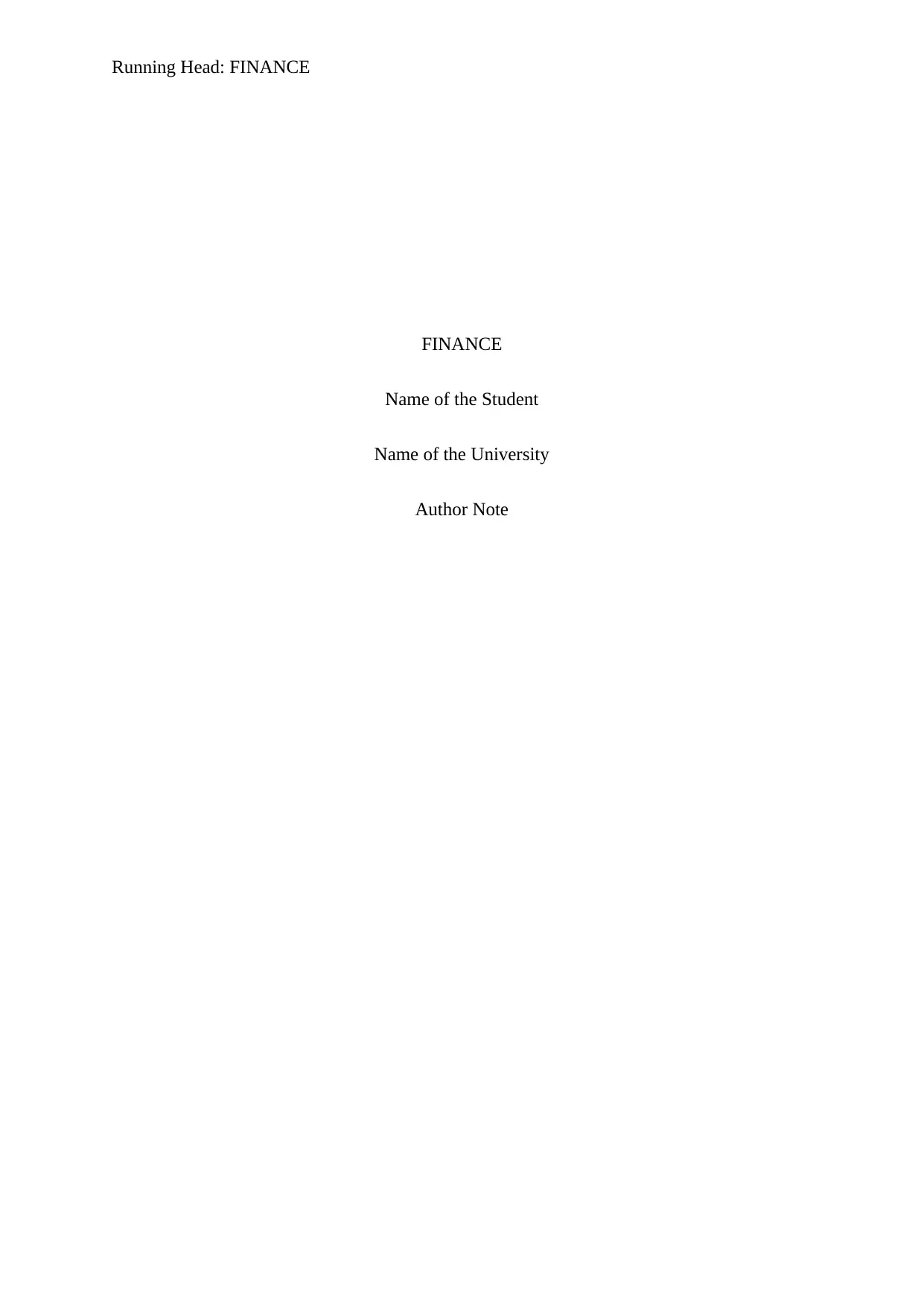
Running Head: FINANCE
FINANCE
Name of the Student
Name of the University
Author Note
FINANCE
Name of the Student
Name of the University
Author Note
Paraphrase This Document
Need a fresh take? Get an instant paraphrase of this document with our AI Paraphraser
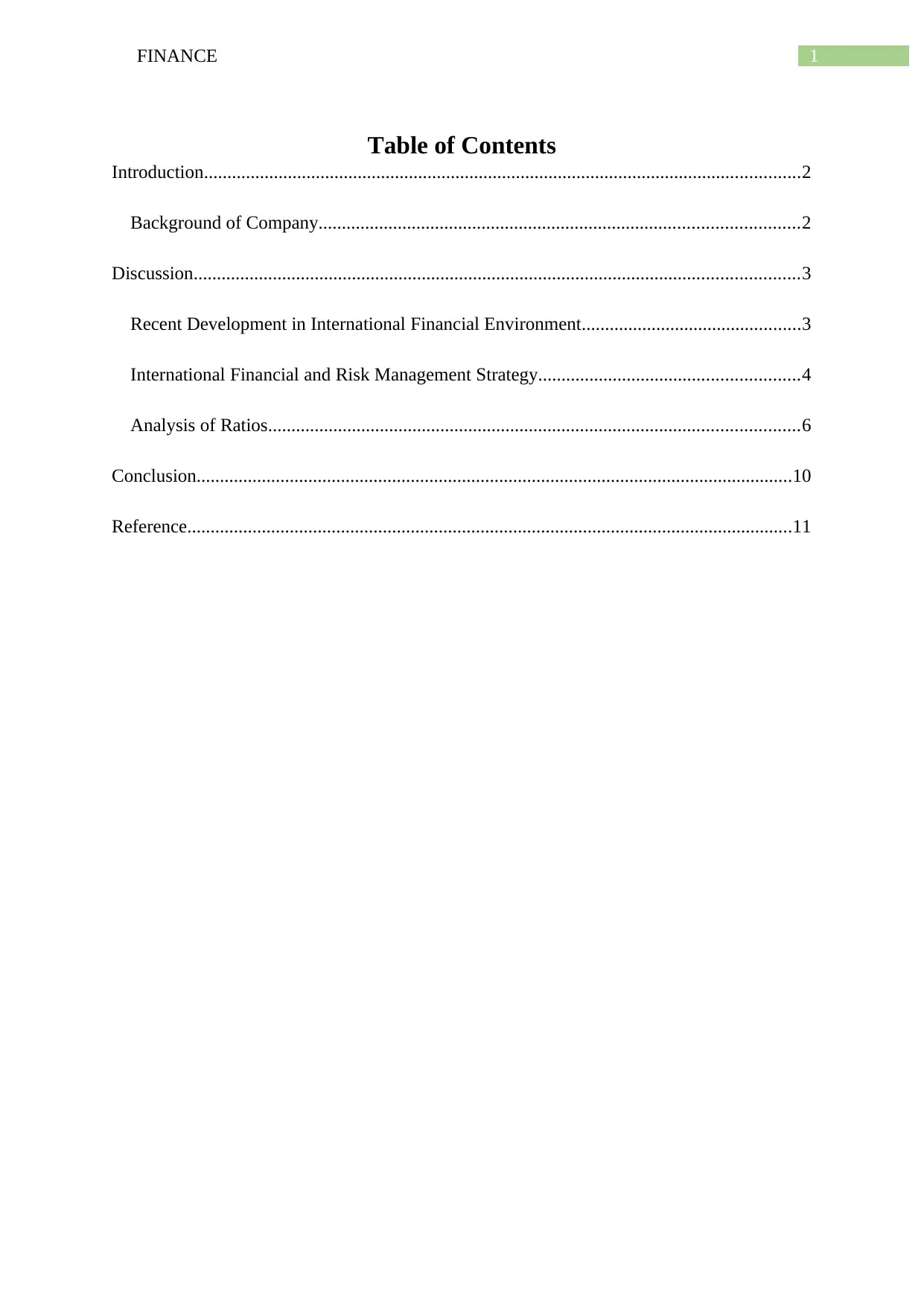
1FINANCE
Table of Contents
Introduction................................................................................................................................2
Background of Company.......................................................................................................2
Discussion..................................................................................................................................3
Recent Development in International Financial Environment...............................................3
International Financial and Risk Management Strategy........................................................4
Analysis of Ratios..................................................................................................................6
Conclusion................................................................................................................................10
Reference..................................................................................................................................11
Table of Contents
Introduction................................................................................................................................2
Background of Company.......................................................................................................2
Discussion..................................................................................................................................3
Recent Development in International Financial Environment...............................................3
International Financial and Risk Management Strategy........................................................4
Analysis of Ratios..................................................................................................................6
Conclusion................................................................................................................................10
Reference..................................................................................................................................11
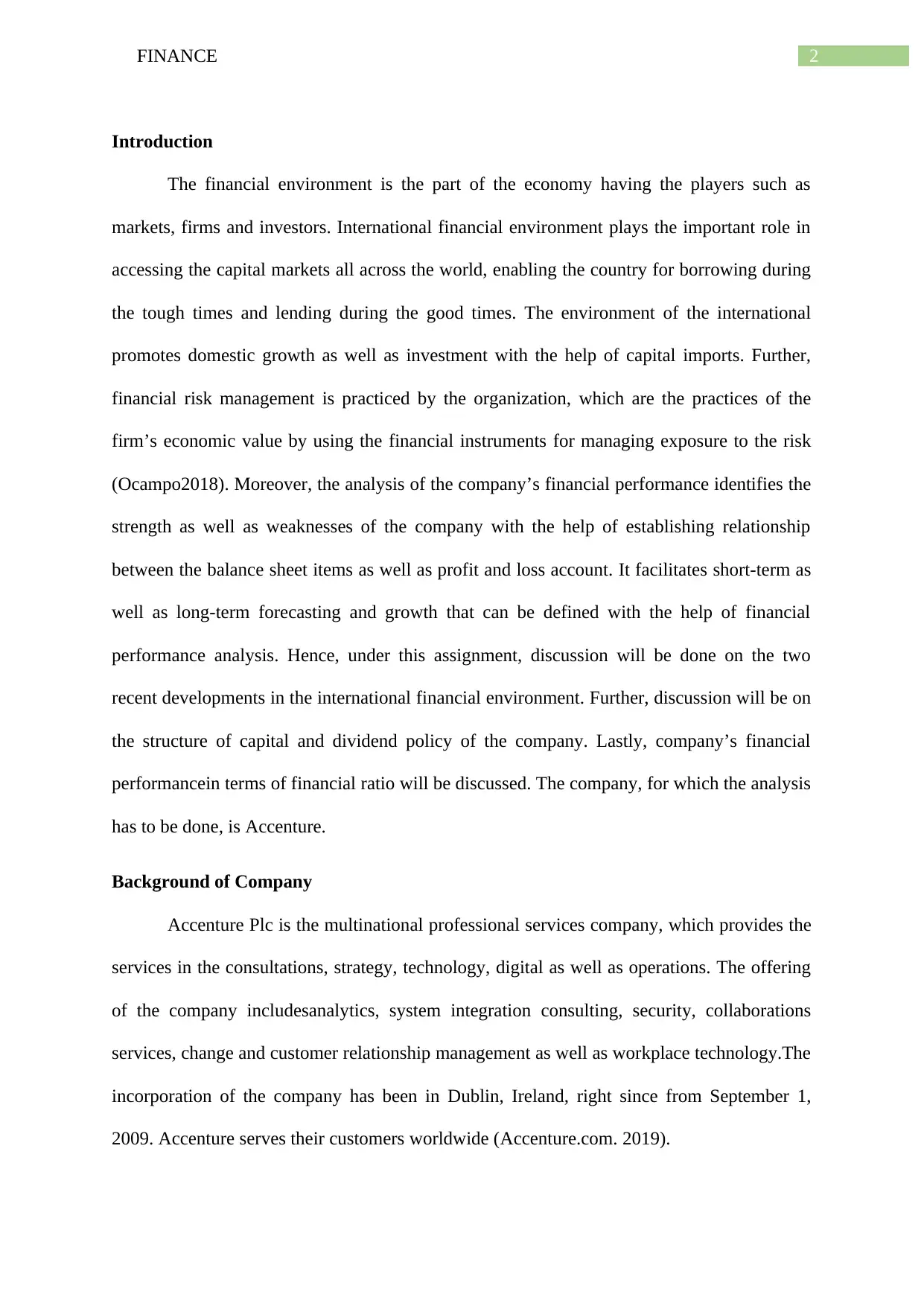
2FINANCE
Introduction
The financial environment is the part of the economy having the players such as
markets, firms and investors. International financial environment plays the important role in
accessing the capital markets all across the world, enabling the country for borrowing during
the tough times and lending during the good times. The environment of the international
promotes domestic growth as well as investment with the help of capital imports. Further,
financial risk management is practiced by the organization, which are the practices of the
firm’s economic value by using the financial instruments for managing exposure to the risk
(Ocampo2018). Moreover, the analysis of the company’s financial performance identifies the
strength as well as weaknesses of the company with the help of establishing relationship
between the balance sheet items as well as profit and loss account. It facilitates short-term as
well as long-term forecasting and growth that can be defined with the help of financial
performance analysis. Hence, under this assignment, discussion will be done on the two
recent developments in the international financial environment. Further, discussion will be on
the structure of capital and dividend policy of the company. Lastly, company’s financial
performancein terms of financial ratio will be discussed. The company, for which the analysis
has to be done, is Accenture.
Background of Company
Accenture Plc is the multinational professional services company, which provides the
services in the consultations, strategy, technology, digital as well as operations. The offering
of the company includesanalytics, system integration consulting, security, collaborations
services, change and customer relationship management as well as workplace technology.The
incorporation of the company has been in Dublin, Ireland, right since from September 1,
2009. Accenture serves their customers worldwide (Accenture.com. 2019).
Introduction
The financial environment is the part of the economy having the players such as
markets, firms and investors. International financial environment plays the important role in
accessing the capital markets all across the world, enabling the country for borrowing during
the tough times and lending during the good times. The environment of the international
promotes domestic growth as well as investment with the help of capital imports. Further,
financial risk management is practiced by the organization, which are the practices of the
firm’s economic value by using the financial instruments for managing exposure to the risk
(Ocampo2018). Moreover, the analysis of the company’s financial performance identifies the
strength as well as weaknesses of the company with the help of establishing relationship
between the balance sheet items as well as profit and loss account. It facilitates short-term as
well as long-term forecasting and growth that can be defined with the help of financial
performance analysis. Hence, under this assignment, discussion will be done on the two
recent developments in the international financial environment. Further, discussion will be on
the structure of capital and dividend policy of the company. Lastly, company’s financial
performancein terms of financial ratio will be discussed. The company, for which the analysis
has to be done, is Accenture.
Background of Company
Accenture Plc is the multinational professional services company, which provides the
services in the consultations, strategy, technology, digital as well as operations. The offering
of the company includesanalytics, system integration consulting, security, collaborations
services, change and customer relationship management as well as workplace technology.The
incorporation of the company has been in Dublin, Ireland, right since from September 1,
2009. Accenture serves their customers worldwide (Accenture.com. 2019).
⊘ This is a preview!⊘
Do you want full access?
Subscribe today to unlock all pages.

Trusted by 1+ million students worldwide
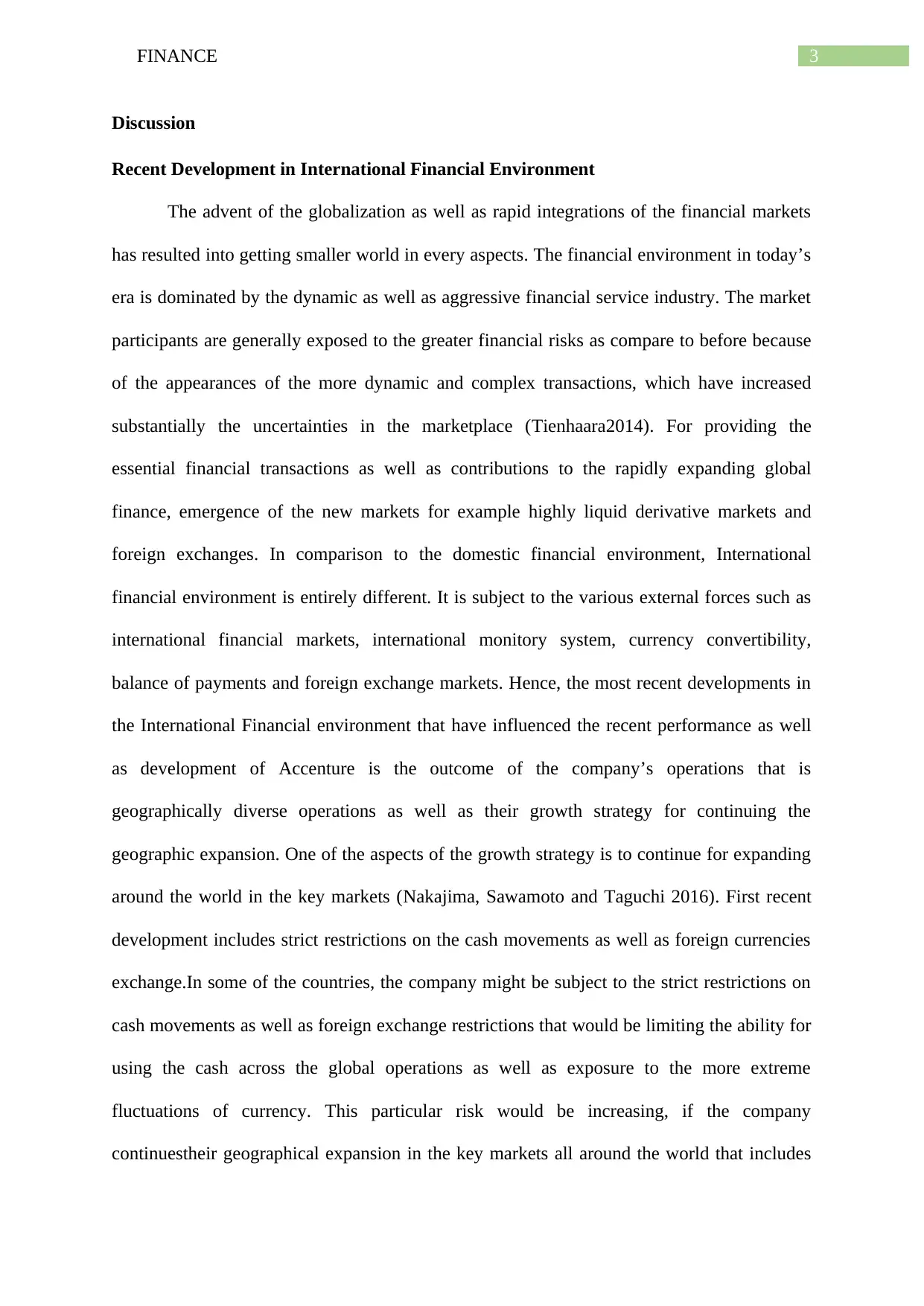
3FINANCE
Discussion
Recent Development in International Financial Environment
The advent of the globalization as well as rapid integrations of the financial markets
has resulted into getting smaller world in every aspects. The financial environment in today’s
era is dominated by the dynamic as well as aggressive financial service industry. The market
participants are generally exposed to the greater financial risks as compare to before because
of the appearances of the more dynamic and complex transactions, which have increased
substantially the uncertainties in the marketplace (Tienhaara2014). For providing the
essential financial transactions as well as contributions to the rapidly expanding global
finance, emergence of the new markets for example highly liquid derivative markets and
foreign exchanges. In comparison to the domestic financial environment, International
financial environment is entirely different. It is subject to the various external forces such as
international financial markets, international monitory system, currency convertibility,
balance of payments and foreign exchange markets. Hence, the most recent developments in
the International Financial environment that have influenced the recent performance as well
as development of Accenture is the outcome of the company’s operations that is
geographically diverse operations as well as their growth strategy for continuing the
geographic expansion. One of the aspects of the growth strategy is to continue for expanding
around the world in the key markets (Nakajima, Sawamoto and Taguchi 2016). First recent
development includes strict restrictions on the cash movements as well as foreign currencies
exchange.In some of the countries, the company might be subject to the strict restrictions on
cash movements as well as foreign exchange restrictions that would be limiting the ability for
using the cash across the global operations as well as exposure to the more extreme
fluctuations of currency. This particular risk would be increasing, if the company
continuestheir geographical expansion in the key markets all around the world that includes
Discussion
Recent Development in International Financial Environment
The advent of the globalization as well as rapid integrations of the financial markets
has resulted into getting smaller world in every aspects. The financial environment in today’s
era is dominated by the dynamic as well as aggressive financial service industry. The market
participants are generally exposed to the greater financial risks as compare to before because
of the appearances of the more dynamic and complex transactions, which have increased
substantially the uncertainties in the marketplace (Tienhaara2014). For providing the
essential financial transactions as well as contributions to the rapidly expanding global
finance, emergence of the new markets for example highly liquid derivative markets and
foreign exchanges. In comparison to the domestic financial environment, International
financial environment is entirely different. It is subject to the various external forces such as
international financial markets, international monitory system, currency convertibility,
balance of payments and foreign exchange markets. Hence, the most recent developments in
the International Financial environment that have influenced the recent performance as well
as development of Accenture is the outcome of the company’s operations that is
geographically diverse operations as well as their growth strategy for continuing the
geographic expansion. One of the aspects of the growth strategy is to continue for expanding
around the world in the key markets (Nakajima, Sawamoto and Taguchi 2016). First recent
development includes strict restrictions on the cash movements as well as foreign currencies
exchange.In some of the countries, the company might be subject to the strict restrictions on
cash movements as well as foreign exchange restrictions that would be limiting the ability for
using the cash across the global operations as well as exposure to the more extreme
fluctuations of currency. This particular risk would be increasing, if the company
continuestheir geographical expansion in the key markets all around the world that includes
Paraphrase This Document
Need a fresh take? Get an instant paraphrase of this document with our AI Paraphraser
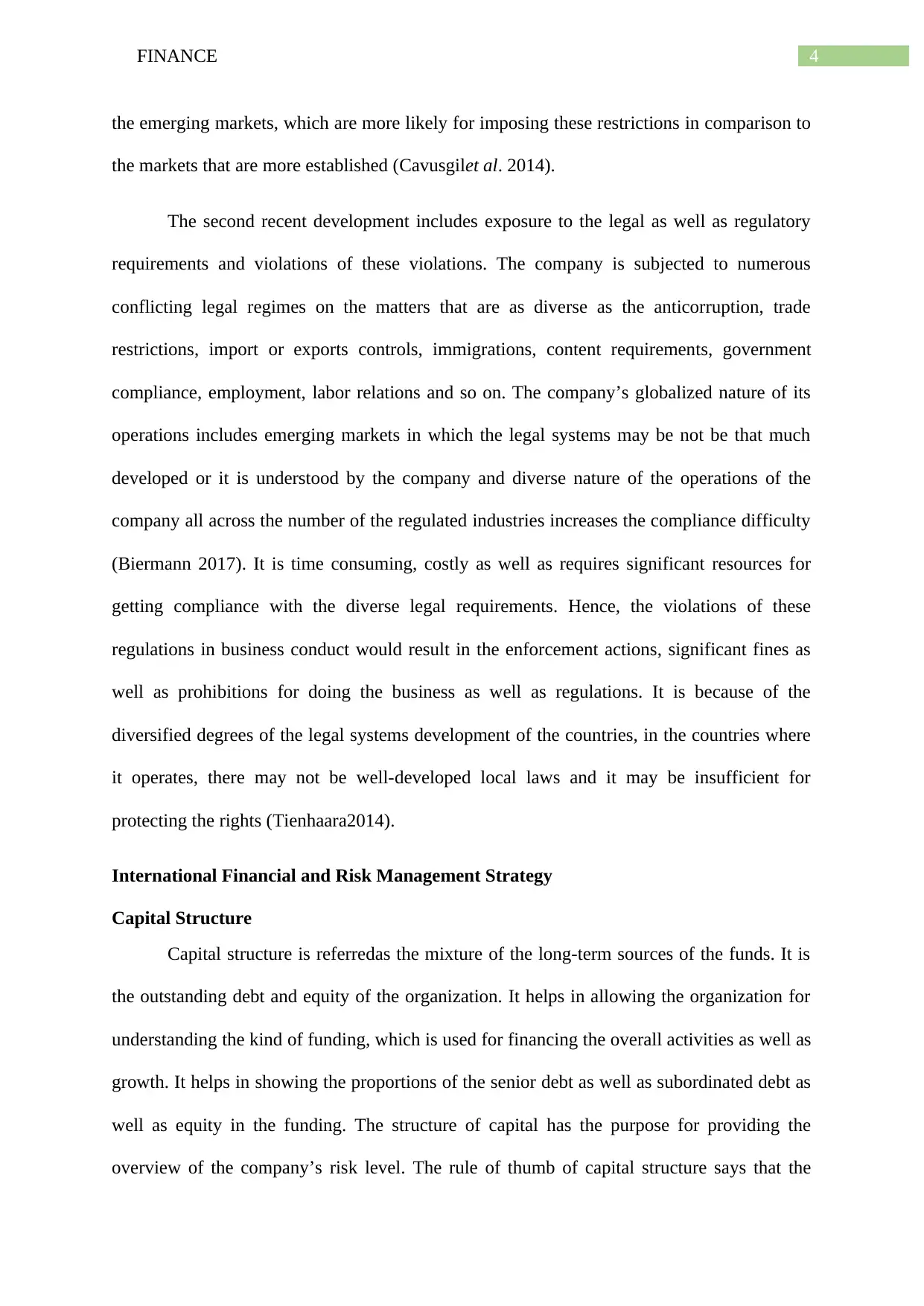
4FINANCE
the emerging markets, which are more likely for imposing these restrictions in comparison to
the markets that are more established (Cavusgilet al. 2014).
The second recent development includes exposure to the legal as well as regulatory
requirements and violations of these violations. The company is subjected to numerous
conflicting legal regimes on the matters that are as diverse as the anticorruption, trade
restrictions, import or exports controls, immigrations, content requirements, government
compliance, employment, labor relations and so on. The company’s globalized nature of its
operations includes emerging markets in which the legal systems may be not be that much
developed or it is understood by the company and diverse nature of the operations of the
company all across the number of the regulated industries increases the compliance difficulty
(Biermann 2017). It is time consuming, costly as well as requires significant resources for
getting compliance with the diverse legal requirements. Hence, the violations of these
regulations in business conduct would result in the enforcement actions, significant fines as
well as prohibitions for doing the business as well as regulations. It is because of the
diversified degrees of the legal systems development of the countries, in the countries where
it operates, there may not be well-developed local laws and it may be insufficient for
protecting the rights (Tienhaara2014).
International Financial and Risk Management Strategy
Capital Structure
Capital structure is referredas the mixture of the long-term sources of the funds. It is
the outstanding debt and equity of the organization. It helps in allowing the organization for
understanding the kind of funding, which is used for financing the overall activities as well as
growth. It helps in showing the proportions of the senior debt as well as subordinated debt as
well as equity in the funding. The structure of capital has the purpose for providing the
overview of the company’s risk level. The rule of thumb of capital structure says that the
the emerging markets, which are more likely for imposing these restrictions in comparison to
the markets that are more established (Cavusgilet al. 2014).
The second recent development includes exposure to the legal as well as regulatory
requirements and violations of these violations. The company is subjected to numerous
conflicting legal regimes on the matters that are as diverse as the anticorruption, trade
restrictions, import or exports controls, immigrations, content requirements, government
compliance, employment, labor relations and so on. The company’s globalized nature of its
operations includes emerging markets in which the legal systems may be not be that much
developed or it is understood by the company and diverse nature of the operations of the
company all across the number of the regulated industries increases the compliance difficulty
(Biermann 2017). It is time consuming, costly as well as requires significant resources for
getting compliance with the diverse legal requirements. Hence, the violations of these
regulations in business conduct would result in the enforcement actions, significant fines as
well as prohibitions for doing the business as well as regulations. It is because of the
diversified degrees of the legal systems development of the countries, in the countries where
it operates, there may not be well-developed local laws and it may be insufficient for
protecting the rights (Tienhaara2014).
International Financial and Risk Management Strategy
Capital Structure
Capital structure is referredas the mixture of the long-term sources of the funds. It is
the outstanding debt and equity of the organization. It helps in allowing the organization for
understanding the kind of funding, which is used for financing the overall activities as well as
growth. It helps in showing the proportions of the senior debt as well as subordinated debt as
well as equity in the funding. The structure of capital has the purpose for providing the
overview of the company’s risk level. The rule of thumb of capital structure says that the
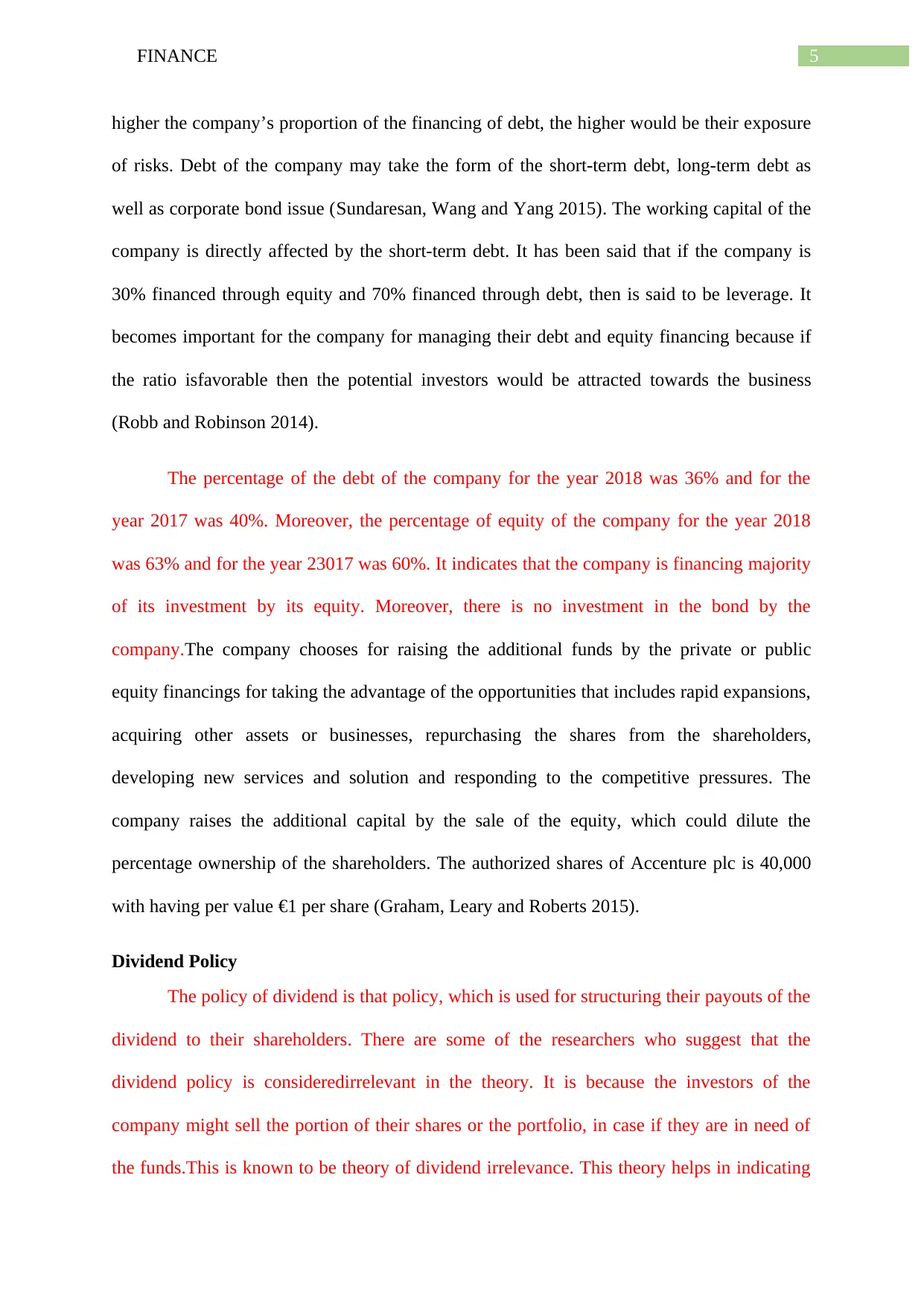
5FINANCE
higher the company’s proportion of the financing of debt, the higher would be their exposure
of risks. Debt of the company may take the form of the short-term debt, long-term debt as
well as corporate bond issue (Sundaresan, Wang and Yang 2015). The working capital of the
company is directly affected by the short-term debt. It has been said that if the company is
30% financed through equity and 70% financed through debt, then is said to be leverage. It
becomes important for the company for managing their debt and equity financing because if
the ratio isfavorable then the potential investors would be attracted towards the business
(Robb and Robinson 2014).
The percentage of the debt of the company for the year 2018 was 36% and for the
year 2017 was 40%. Moreover, the percentage of equity of the company for the year 2018
was 63% and for the year 23017 was 60%. It indicates that the company is financing majority
of its investment by its equity. Moreover, there is no investment in the bond by the
company.The company chooses for raising the additional funds by the private or public
equity financings for taking the advantage of the opportunities that includes rapid expansions,
acquiring other assets or businesses, repurchasing the shares from the shareholders,
developing new services and solution and responding to the competitive pressures. The
company raises the additional capital by the sale of the equity, which could dilute the
percentage ownership of the shareholders. The authorized shares of Accenture plc is 40,000
with having per value €1 per share (Graham, Leary and Roberts 2015).
Dividend Policy
The policy of dividend is that policy, which is used for structuring their payouts of the
dividend to their shareholders. There are some of the researchers who suggest that the
dividend policy is consideredirrelevant in the theory. It is because the investors of the
company might sell the portion of their shares or the portfolio, in case if they are in need of
the funds.This is known to be theory of dividend irrelevance. This theory helps in indicating
higher the company’s proportion of the financing of debt, the higher would be their exposure
of risks. Debt of the company may take the form of the short-term debt, long-term debt as
well as corporate bond issue (Sundaresan, Wang and Yang 2015). The working capital of the
company is directly affected by the short-term debt. It has been said that if the company is
30% financed through equity and 70% financed through debt, then is said to be leverage. It
becomes important for the company for managing their debt and equity financing because if
the ratio isfavorable then the potential investors would be attracted towards the business
(Robb and Robinson 2014).
The percentage of the debt of the company for the year 2018 was 36% and for the
year 2017 was 40%. Moreover, the percentage of equity of the company for the year 2018
was 63% and for the year 23017 was 60%. It indicates that the company is financing majority
of its investment by its equity. Moreover, there is no investment in the bond by the
company.The company chooses for raising the additional funds by the private or public
equity financings for taking the advantage of the opportunities that includes rapid expansions,
acquiring other assets or businesses, repurchasing the shares from the shareholders,
developing new services and solution and responding to the competitive pressures. The
company raises the additional capital by the sale of the equity, which could dilute the
percentage ownership of the shareholders. The authorized shares of Accenture plc is 40,000
with having per value €1 per share (Graham, Leary and Roberts 2015).
Dividend Policy
The policy of dividend is that policy, which is used for structuring their payouts of the
dividend to their shareholders. There are some of the researchers who suggest that the
dividend policy is consideredirrelevant in the theory. It is because the investors of the
company might sell the portion of their shares or the portfolio, in case if they are in need of
the funds.This is known to be theory of dividend irrelevance. This theory helps in indicating
⊘ This is a preview!⊘
Do you want full access?
Subscribe today to unlock all pages.

Trusted by 1+ million students worldwide
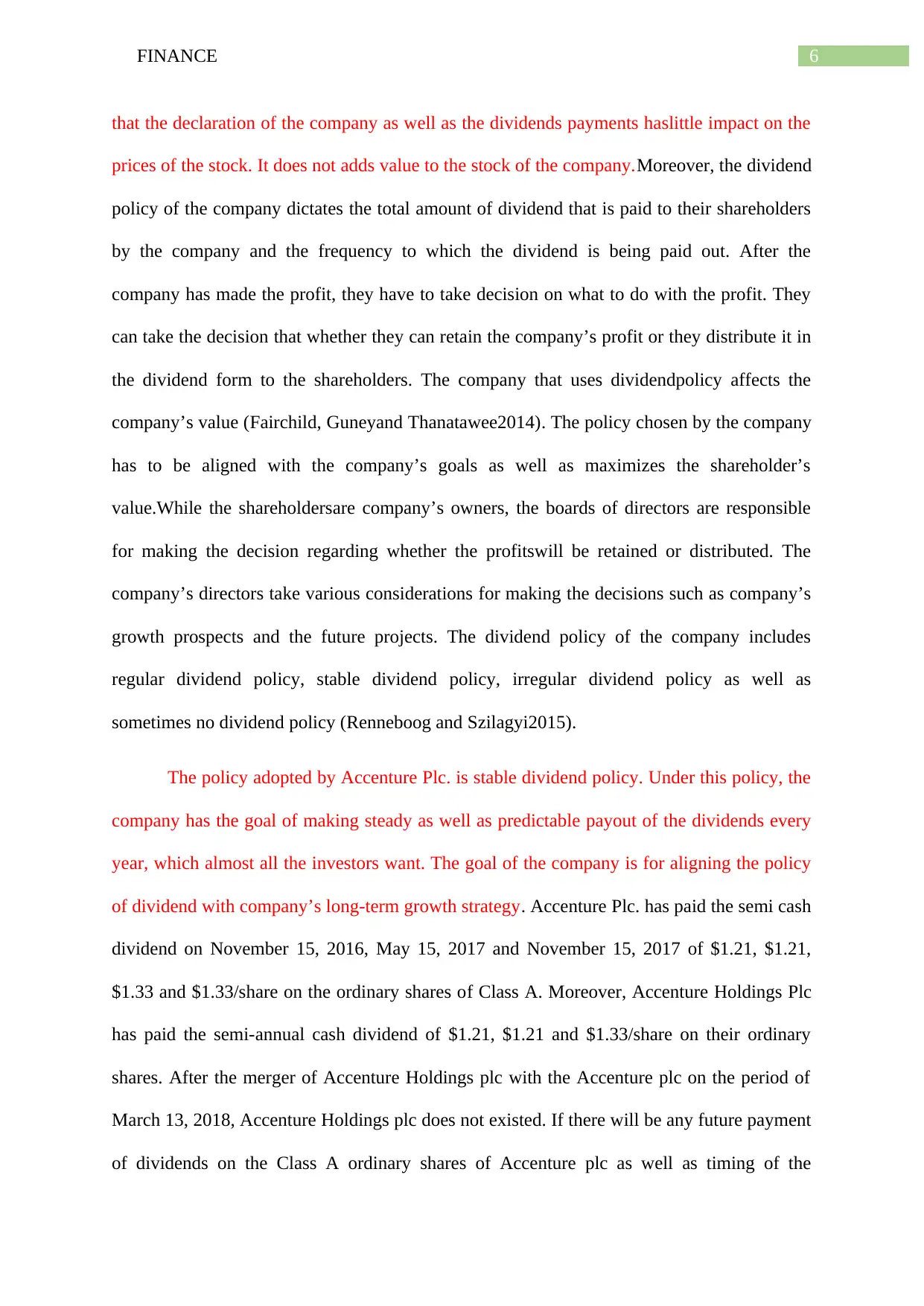
6FINANCE
that the declaration of the company as well as the dividends payments haslittle impact on the
prices of the stock. It does not adds value to the stock of the company.Moreover, the dividend
policy of the company dictates the total amount of dividend that is paid to their shareholders
by the company and the frequency to which the dividend is being paid out. After the
company has made the profit, they have to take decision on what to do with the profit. They
can take the decision that whether they can retain the company’s profit or they distribute it in
the dividend form to the shareholders. The company that uses dividendpolicy affects the
company’s value (Fairchild, Guneyand Thanatawee2014). The policy chosen by the company
has to be aligned with the company’s goals as well as maximizes the shareholder’s
value.While the shareholdersare company’s owners, the boards of directors are responsible
for making the decision regarding whether the profitswill be retained or distributed. The
company’s directors take various considerations for making the decisions such as company’s
growth prospects and the future projects. The dividend policy of the company includes
regular dividend policy, stable dividend policy, irregular dividend policy as well as
sometimes no dividend policy (Renneboog and Szilagyi2015).
The policy adopted by Accenture Plc. is stable dividend policy. Under this policy, the
company has the goal of making steady as well as predictable payout of the dividends every
year, which almost all the investors want. The goal of the company is for aligning the policy
of dividend with company’s long-term growth strategy. Accenture Plc. has paid the semi cash
dividend on November 15, 2016, May 15, 2017 and November 15, 2017 of $1.21, $1.21,
$1.33 and $1.33/share on the ordinary shares of Class A. Moreover, Accenture Holdings Plc
has paid the semi-annual cash dividend of $1.21, $1.21 and $1.33/share on their ordinary
shares. After the merger of Accenture Holdings plc with the Accenture plc on the period of
March 13, 2018, Accenture Holdings plc does not existed. If there will be any future payment
of dividends on the Class A ordinary shares of Accenture plc as well as timing of the
that the declaration of the company as well as the dividends payments haslittle impact on the
prices of the stock. It does not adds value to the stock of the company.Moreover, the dividend
policy of the company dictates the total amount of dividend that is paid to their shareholders
by the company and the frequency to which the dividend is being paid out. After the
company has made the profit, they have to take decision on what to do with the profit. They
can take the decision that whether they can retain the company’s profit or they distribute it in
the dividend form to the shareholders. The company that uses dividendpolicy affects the
company’s value (Fairchild, Guneyand Thanatawee2014). The policy chosen by the company
has to be aligned with the company’s goals as well as maximizes the shareholder’s
value.While the shareholdersare company’s owners, the boards of directors are responsible
for making the decision regarding whether the profitswill be retained or distributed. The
company’s directors take various considerations for making the decisions such as company’s
growth prospects and the future projects. The dividend policy of the company includes
regular dividend policy, stable dividend policy, irregular dividend policy as well as
sometimes no dividend policy (Renneboog and Szilagyi2015).
The policy adopted by Accenture Plc. is stable dividend policy. Under this policy, the
company has the goal of making steady as well as predictable payout of the dividends every
year, which almost all the investors want. The goal of the company is for aligning the policy
of dividend with company’s long-term growth strategy. Accenture Plc. has paid the semi cash
dividend on November 15, 2016, May 15, 2017 and November 15, 2017 of $1.21, $1.21,
$1.33 and $1.33/share on the ordinary shares of Class A. Moreover, Accenture Holdings Plc
has paid the semi-annual cash dividend of $1.21, $1.21 and $1.33/share on their ordinary
shares. After the merger of Accenture Holdings plc with the Accenture plc on the period of
March 13, 2018, Accenture Holdings plc does not existed. If there will be any future payment
of dividends on the Class A ordinary shares of Accenture plc as well as timing of the
Paraphrase This Document
Need a fresh take? Get an instant paraphrase of this document with our AI Paraphraser
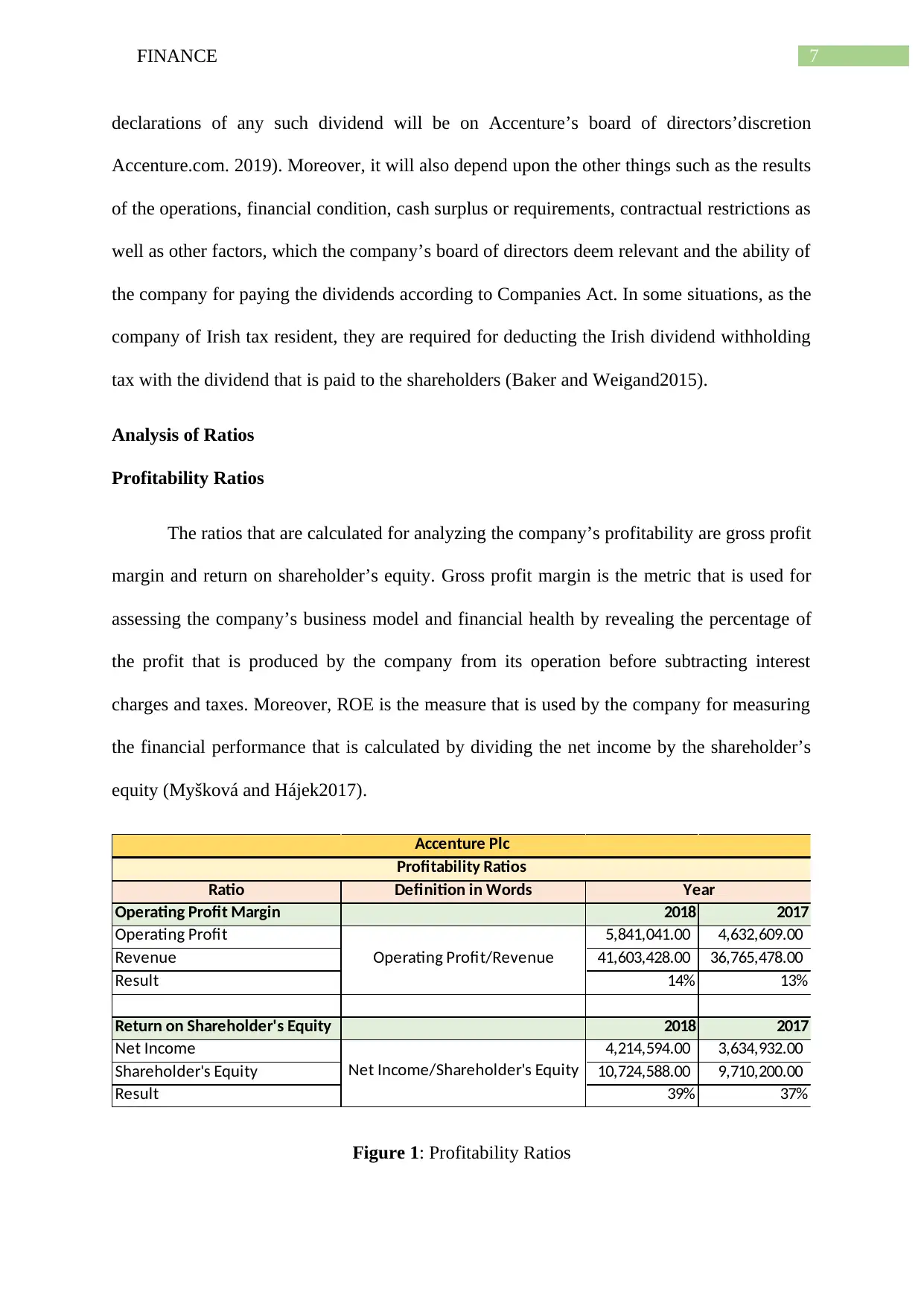
7FINANCE
declarations of any such dividend will be on Accenture’s board of directors’discretion
Accenture.com. 2019). Moreover, it will also depend upon the other things such as the results
of the operations, financial condition, cash surplus or requirements, contractual restrictions as
well as other factors, which the company’s board of directors deem relevant and the ability of
the company for paying the dividends according to Companies Act. In some situations, as the
company of Irish tax resident, they are required for deducting the Irish dividend withholding
tax with the dividend that is paid to the shareholders (Baker and Weigand2015).
Analysis of Ratios
Profitability Ratios
The ratios that are calculated for analyzing the company’s profitability are gross profit
margin and return on shareholder’s equity. Gross profit margin is the metric that is used for
assessing the company’s business model and financial health by revealing the percentage of
the profit that is produced by the company from its operation before subtracting interest
charges and taxes. Moreover, ROE is the measure that is used by the company for measuring
the financial performance that is calculated by dividing the net income by the shareholder’s
equity (Myšková and Hájek2017).
Ratio Definition in Words
Operating Profit Margin 2018 2017
Operating Profit 5,841,041.00 4,632,609.00
Revenue 41,603,428.00 36,765,478.00
Result 14% 13%
Return on Shareholder's Equity 2018 2017
Net Income 4,214,594.00 3,634,932.00
Shareholder's Equity 10,724,588.00 9,710,200.00
Result 39% 37%
Year
Accenture Plc
Profitability Ratios
Operating Profit/Revenue
Net Income/Shareholder's Equity
Figure 1: Profitability Ratios
declarations of any such dividend will be on Accenture’s board of directors’discretion
Accenture.com. 2019). Moreover, it will also depend upon the other things such as the results
of the operations, financial condition, cash surplus or requirements, contractual restrictions as
well as other factors, which the company’s board of directors deem relevant and the ability of
the company for paying the dividends according to Companies Act. In some situations, as the
company of Irish tax resident, they are required for deducting the Irish dividend withholding
tax with the dividend that is paid to the shareholders (Baker and Weigand2015).
Analysis of Ratios
Profitability Ratios
The ratios that are calculated for analyzing the company’s profitability are gross profit
margin and return on shareholder’s equity. Gross profit margin is the metric that is used for
assessing the company’s business model and financial health by revealing the percentage of
the profit that is produced by the company from its operation before subtracting interest
charges and taxes. Moreover, ROE is the measure that is used by the company for measuring
the financial performance that is calculated by dividing the net income by the shareholder’s
equity (Myšková and Hájek2017).
Ratio Definition in Words
Operating Profit Margin 2018 2017
Operating Profit 5,841,041.00 4,632,609.00
Revenue 41,603,428.00 36,765,478.00
Result 14% 13%
Return on Shareholder's Equity 2018 2017
Net Income 4,214,594.00 3,634,932.00
Shareholder's Equity 10,724,588.00 9,710,200.00
Result 39% 37%
Year
Accenture Plc
Profitability Ratios
Operating Profit/Revenue
Net Income/Shareholder's Equity
Figure 1: Profitability Ratios
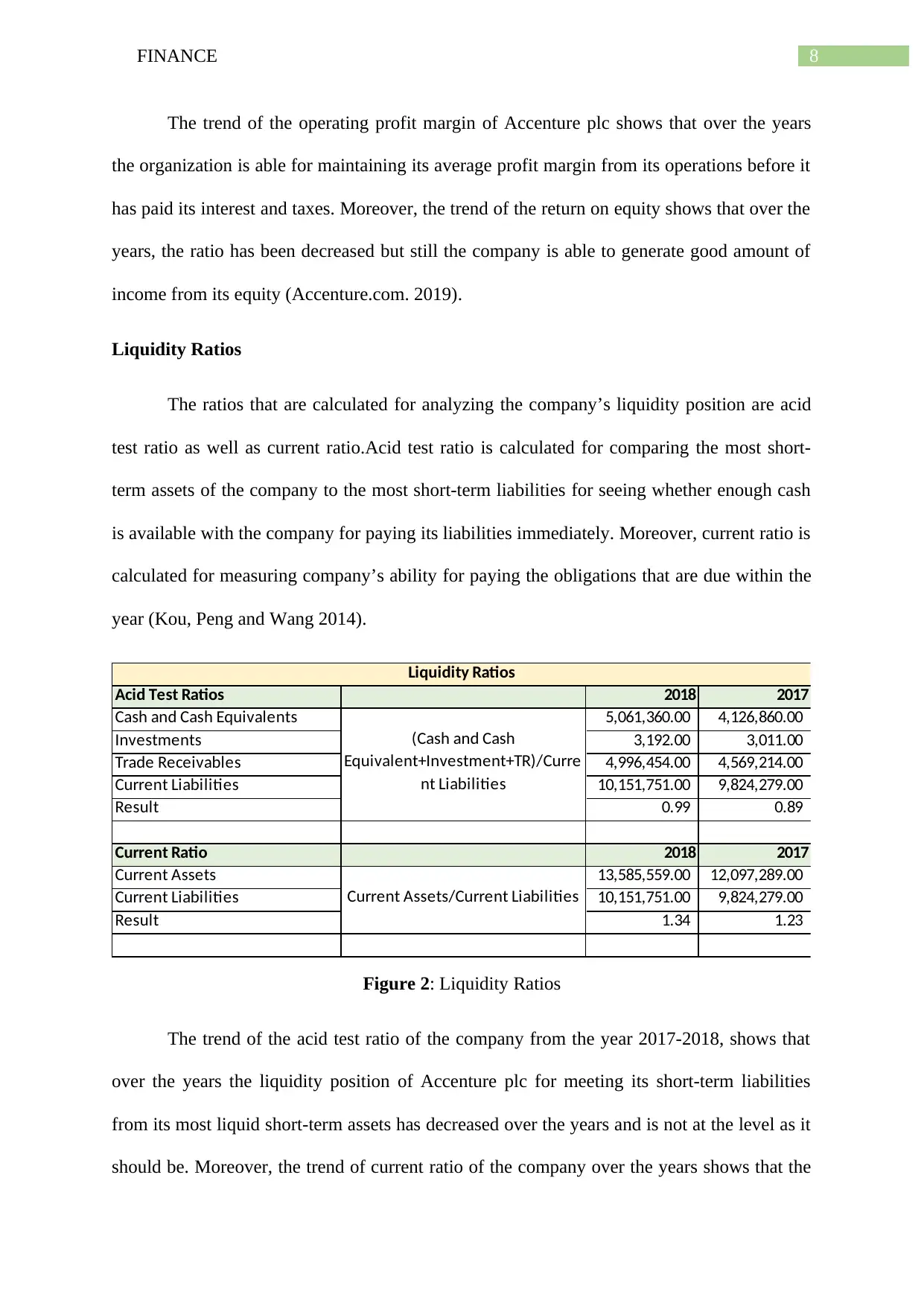
8FINANCE
The trend of the operating profit margin of Accenture plc shows that over the years
the organization is able for maintaining its average profit margin from its operations before it
has paid its interest and taxes. Moreover, the trend of the return on equity shows that over the
years, the ratio has been decreased but still the company is able to generate good amount of
income from its equity (Accenture.com. 2019).
Liquidity Ratios
The ratios that are calculated for analyzing the company’s liquidity position are acid
test ratio as well as current ratio.Acid test ratio is calculated for comparing the most short-
term assets of the company to the most short-term liabilities for seeing whether enough cash
is available with the company for paying its liabilities immediately. Moreover, current ratio is
calculated for measuring company’s ability for paying the obligations that are due within the
year (Kou, Peng and Wang 2014).
Acid Test Ratios 2018 2017
Cash and Cash Equivalents 5,061,360.00 4,126,860.00
Investments 3,192.00 3,011.00
Trade Receivables 4,996,454.00 4,569,214.00
Current Liabilities 10,151,751.00 9,824,279.00
Result 0.99 0.89
Current Ratio 2018 2017
Current Assets 13,585,559.00 12,097,289.00
Current Liabilities 10,151,751.00 9,824,279.00
Result 1.34 1.23
Liquidity Ratios
(Cash and Cash
Equivalent+Investment+TR)/Curre
nt Liabilities
Current Assets/Current Liabilities
Figure 2: Liquidity Ratios
The trend of the acid test ratio of the company from the year 2017-2018, shows that
over the years the liquidity position of Accenture plc for meeting its short-term liabilities
from its most liquid short-term assets has decreased over the years and is not at the level as it
should be. Moreover, the trend of current ratio of the company over the years shows that the
The trend of the operating profit margin of Accenture plc shows that over the years
the organization is able for maintaining its average profit margin from its operations before it
has paid its interest and taxes. Moreover, the trend of the return on equity shows that over the
years, the ratio has been decreased but still the company is able to generate good amount of
income from its equity (Accenture.com. 2019).
Liquidity Ratios
The ratios that are calculated for analyzing the company’s liquidity position are acid
test ratio as well as current ratio.Acid test ratio is calculated for comparing the most short-
term assets of the company to the most short-term liabilities for seeing whether enough cash
is available with the company for paying its liabilities immediately. Moreover, current ratio is
calculated for measuring company’s ability for paying the obligations that are due within the
year (Kou, Peng and Wang 2014).
Acid Test Ratios 2018 2017
Cash and Cash Equivalents 5,061,360.00 4,126,860.00
Investments 3,192.00 3,011.00
Trade Receivables 4,996,454.00 4,569,214.00
Current Liabilities 10,151,751.00 9,824,279.00
Result 0.99 0.89
Current Ratio 2018 2017
Current Assets 13,585,559.00 12,097,289.00
Current Liabilities 10,151,751.00 9,824,279.00
Result 1.34 1.23
Liquidity Ratios
(Cash and Cash
Equivalent+Investment+TR)/Curre
nt Liabilities
Current Assets/Current Liabilities
Figure 2: Liquidity Ratios
The trend of the acid test ratio of the company from the year 2017-2018, shows that
over the years the liquidity position of Accenture plc for meeting its short-term liabilities
from its most liquid short-term assets has decreased over the years and is not at the level as it
should be. Moreover, the trend of current ratio of the company over the years shows that the
⊘ This is a preview!⊘
Do you want full access?
Subscribe today to unlock all pages.

Trusted by 1+ million students worldwide
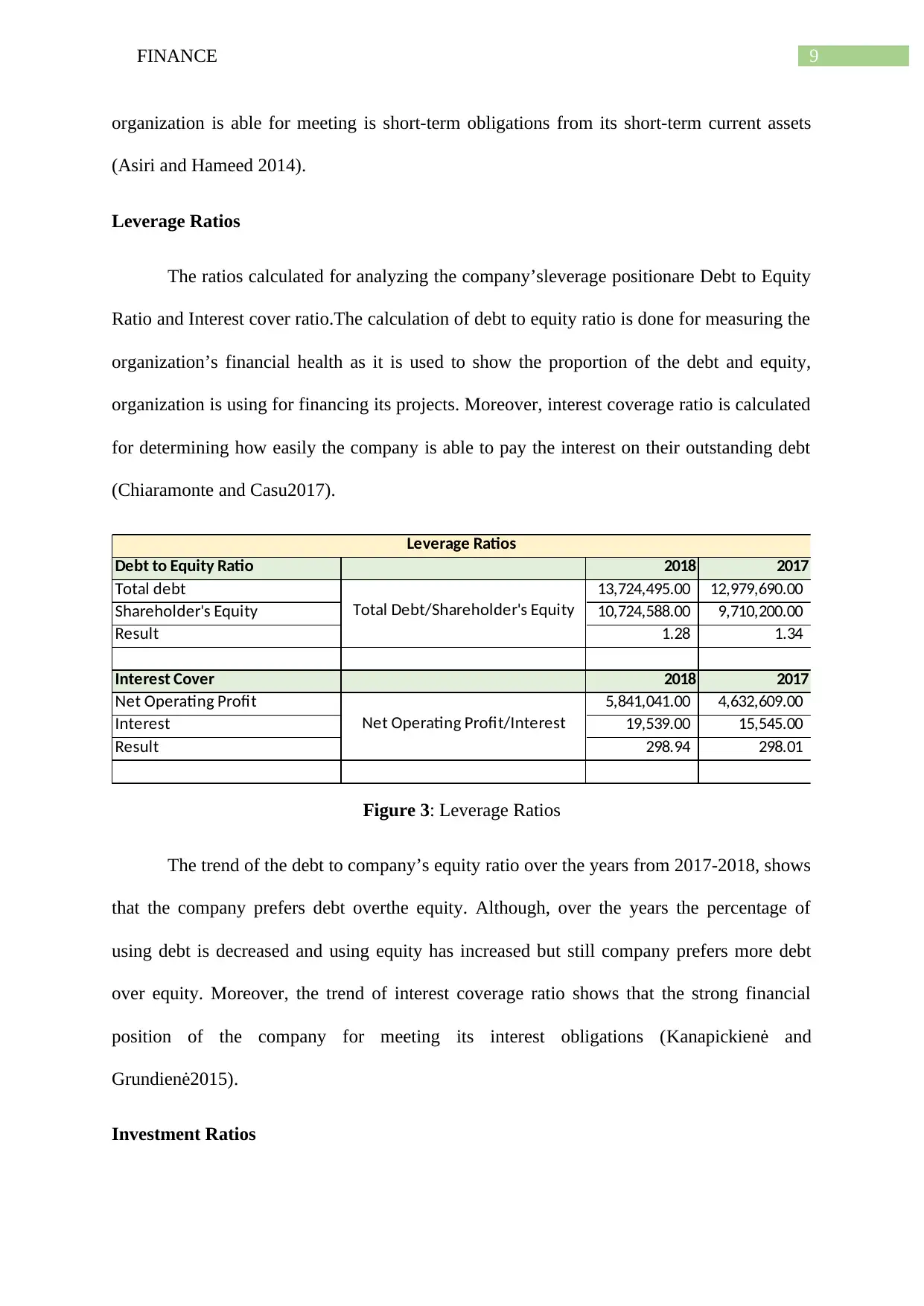
9FINANCE
organization is able for meeting is short-term obligations from its short-term current assets
(Asiri and Hameed 2014).
Leverage Ratios
The ratios calculated for analyzing the company’sleverage positionare Debt to Equity
Ratio and Interest cover ratio.The calculation of debt to equity ratio is done for measuring the
organization’s financial health as it is used to show the proportion of the debt and equity,
organization is using for financing its projects. Moreover, interest coverage ratio is calculated
for determining how easily the company is able to pay the interest on their outstanding debt
(Chiaramonte and Casu2017).
Debt to Equity Ratio 2018 2017
Total debt 13,724,495.00 12,979,690.00
Shareholder's Equity 10,724,588.00 9,710,200.00
Result 1.28 1.34
Interest Cover 2018 2017
Net Operating Profit 5,841,041.00 4,632,609.00
Interest 19,539.00 15,545.00
Result 298.94 298.01
Leverage Ratios
Total Debt/Shareholder's Equity
Net Operating Profit/Interest
Figure 3: Leverage Ratios
The trend of the debt to company’s equity ratio over the years from 2017-2018, shows
that the company prefers debt overthe equity. Although, over the years the percentage of
using debt is decreased and using equity has increased but still company prefers more debt
over equity. Moreover, the trend of interest coverage ratio shows that the strong financial
position of the company for meeting its interest obligations (Kanapickienė and
Grundienė2015).
Investment Ratios
organization is able for meeting is short-term obligations from its short-term current assets
(Asiri and Hameed 2014).
Leverage Ratios
The ratios calculated for analyzing the company’sleverage positionare Debt to Equity
Ratio and Interest cover ratio.The calculation of debt to equity ratio is done for measuring the
organization’s financial health as it is used to show the proportion of the debt and equity,
organization is using for financing its projects. Moreover, interest coverage ratio is calculated
for determining how easily the company is able to pay the interest on their outstanding debt
(Chiaramonte and Casu2017).
Debt to Equity Ratio 2018 2017
Total debt 13,724,495.00 12,979,690.00
Shareholder's Equity 10,724,588.00 9,710,200.00
Result 1.28 1.34
Interest Cover 2018 2017
Net Operating Profit 5,841,041.00 4,632,609.00
Interest 19,539.00 15,545.00
Result 298.94 298.01
Leverage Ratios
Total Debt/Shareholder's Equity
Net Operating Profit/Interest
Figure 3: Leverage Ratios
The trend of the debt to company’s equity ratio over the years from 2017-2018, shows
that the company prefers debt overthe equity. Although, over the years the percentage of
using debt is decreased and using equity has increased but still company prefers more debt
over equity. Moreover, the trend of interest coverage ratio shows that the strong financial
position of the company for meeting its interest obligations (Kanapickienė and
Grundienė2015).
Investment Ratios
Paraphrase This Document
Need a fresh take? Get an instant paraphrase of this document with our AI Paraphraser
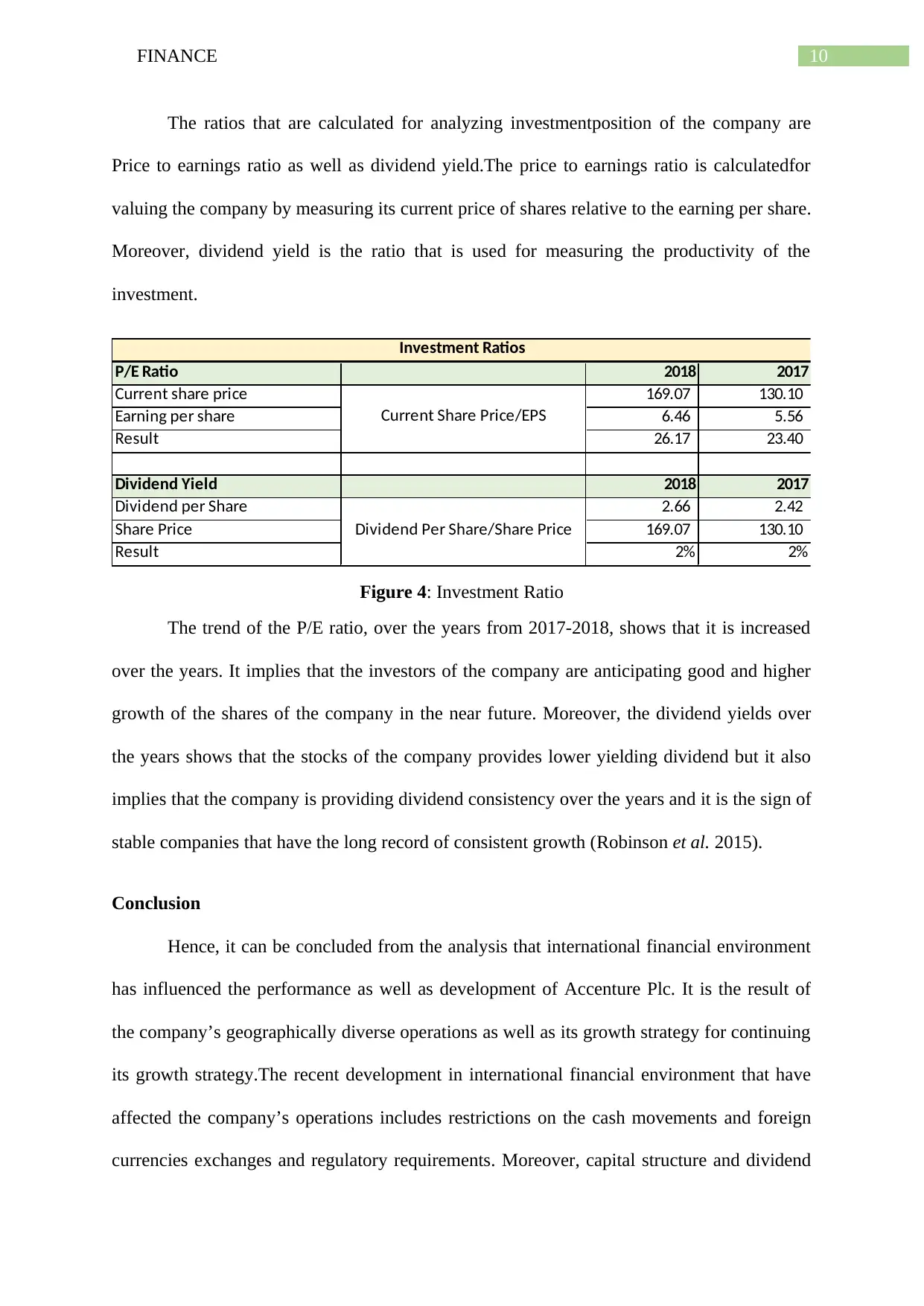
10FINANCE
The ratios that are calculated for analyzing investmentposition of the company are
Price to earnings ratio as well as dividend yield.The price to earnings ratio is calculatedfor
valuing the company by measuring its current price of shares relative to the earning per share.
Moreover, dividend yield is the ratio that is used for measuring the productivity of the
investment.
P/E Ratio 2018 2017
Current share price 169.07 130.10
Earning per share 6.46 5.56
Result 26.17 23.40
Dividend Yield 2018 2017
Dividend per Share 2.66 2.42
Share Price 169.07 130.10
Result 2% 2%
Current Share Price/EPS
Dividend Per Share/Share Price
Investment Ratios
Figure 4: Investment Ratio
The trend of the P/E ratio, over the years from 2017-2018, shows that it is increased
over the years. It implies that the investors of the company are anticipating good and higher
growth of the shares of the company in the near future. Moreover, the dividend yields over
the years shows that the stocks of the company provides lower yielding dividend but it also
implies that the company is providing dividend consistency over the years and it is the sign of
stable companies that have the long record of consistent growth (Robinson et al. 2015).
Conclusion
Hence, it can be concluded from the analysis that international financial environment
has influenced the performance as well as development of Accenture Plc. It is the result of
the company’s geographically diverse operations as well as its growth strategy for continuing
its growth strategy.The recent development in international financial environment that have
affected the company’s operations includes restrictions on the cash movements and foreign
currencies exchanges and regulatory requirements. Moreover, capital structure and dividend
The ratios that are calculated for analyzing investmentposition of the company are
Price to earnings ratio as well as dividend yield.The price to earnings ratio is calculatedfor
valuing the company by measuring its current price of shares relative to the earning per share.
Moreover, dividend yield is the ratio that is used for measuring the productivity of the
investment.
P/E Ratio 2018 2017
Current share price 169.07 130.10
Earning per share 6.46 5.56
Result 26.17 23.40
Dividend Yield 2018 2017
Dividend per Share 2.66 2.42
Share Price 169.07 130.10
Result 2% 2%
Current Share Price/EPS
Dividend Per Share/Share Price
Investment Ratios
Figure 4: Investment Ratio
The trend of the P/E ratio, over the years from 2017-2018, shows that it is increased
over the years. It implies that the investors of the company are anticipating good and higher
growth of the shares of the company in the near future. Moreover, the dividend yields over
the years shows that the stocks of the company provides lower yielding dividend but it also
implies that the company is providing dividend consistency over the years and it is the sign of
stable companies that have the long record of consistent growth (Robinson et al. 2015).
Conclusion
Hence, it can be concluded from the analysis that international financial environment
has influenced the performance as well as development of Accenture Plc. It is the result of
the company’s geographically diverse operations as well as its growth strategy for continuing
its growth strategy.The recent development in international financial environment that have
affected the company’s operations includes restrictions on the cash movements and foreign
currencies exchanges and regulatory requirements. Moreover, capital structure and dividend
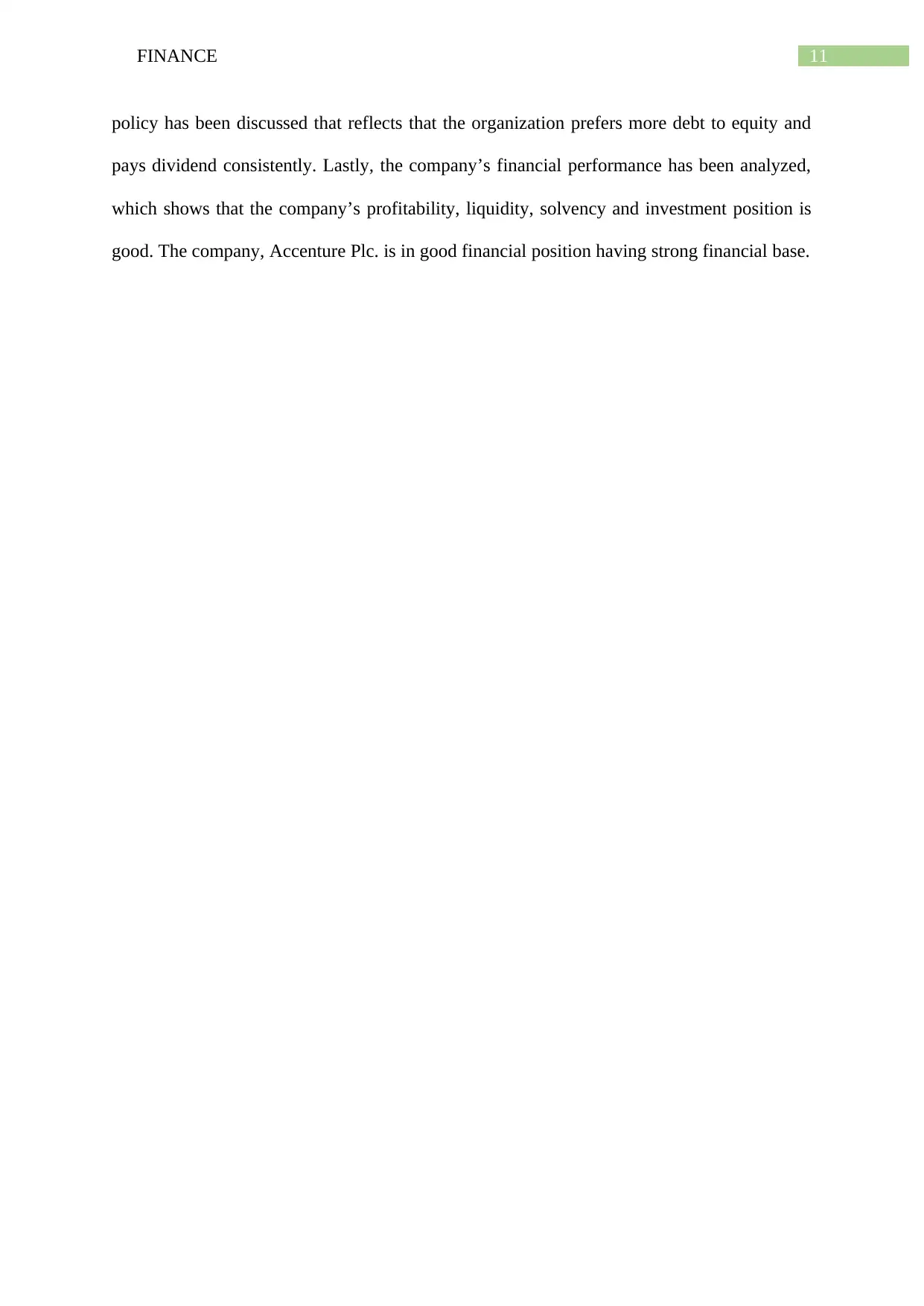
11FINANCE
policy has been discussed that reflects that the organization prefers more debt to equity and
pays dividend consistently. Lastly, the company’s financial performance has been analyzed,
which shows that the company’s profitability, liquidity, solvency and investment position is
good. The company, Accenture Plc. is in good financial position having strong financial base.
policy has been discussed that reflects that the organization prefers more debt to equity and
pays dividend consistently. Lastly, the company’s financial performance has been analyzed,
which shows that the company’s profitability, liquidity, solvency and investment position is
good. The company, Accenture Plc. is in good financial position having strong financial base.
⊘ This is a preview!⊘
Do you want full access?
Subscribe today to unlock all pages.

Trusted by 1+ million students worldwide
1 out of 16
Related Documents
Your All-in-One AI-Powered Toolkit for Academic Success.
+13062052269
info@desklib.com
Available 24*7 on WhatsApp / Email
![[object Object]](/_next/static/media/star-bottom.7253800d.svg)
Unlock your academic potential
Copyright © 2020–2025 A2Z Services. All Rights Reserved. Developed and managed by ZUCOL.




